986
Views & Citations10
Likes & Shares
INTRODUCTION
Hypertension is reported to be the fourth contributor to premature death in developed countries and the seventh in developing countries. According to the year 2013, World Health Organization (WHO) report, a sudden change in lifestyle and habits paves the way to these chronic diseases [1]. Observed that the prevalence of hypertension is raised in both urban and rural areas in India. Review of epidemiological studies in India shows that the percentage of people affected by hypertension in the sixty years has increased from 2% to 25% especially among people living in rural areas of India. The deaths due to Cardio Vascular Disease (CVD) are highly variable in different parts of India. In India hypertension awareness, treatment and control status are less, with only about 50% of urban and 25% of rural hypertensive patients only are aware of its presence in India. Many interventional programmes for controlling high BP were implemented and the mean BP has decreased in many developed countries.
Prehypertension is not come under in a disease category. It is a sign chosen to identify people with the risk of getting hypertension and it motivates them to prevent from developing hypertension [2].
Valvlack [3] conducted a survey regarding prevalence of hypertension and pre hypertension, lifestyle risk factor in Tamil Nadu. One household level questionnaire and another individual level questionnaire regarding occupational categories were used for survey among 5000 households which included urban and rural areas. It was found 38% of their BP to be normal, 44% of them had pre hypertension, 14% had stage I hypertension and 4% had stage II hypertension. Stage I and II hypertension was more pronounced in men (21%) as compared to women (15%). he prevalence was recorded as increasing with age 7% in 15-24 years, 15% in 25-34 years, 23% in 35-44 years, 36% in 45-54 years and 44% in 55-64 years. Prevalence of hypertension by education was 23% among illiterate and 18% among higher level. The prevalence was higher among occupational categories of service (37%), executive (28%) and agriculture (22%). Low prevalence of hypertension was recorded among the domestic workers (13%). Overall, prevalence of high BP among rural population was 16% and the pattern was increasing with age and high among illiterate (20%). In the rural occupational category, the prevalence was high among service (23%), executive and business class
i(19%), manual worker (18%) and it was low among agriculture (17%).
Overall prevalence of hypertension was 18% in Tamil Nadu. The survey showed that half of the adult population was categorized into prehypertension group. The survey found that about 27% of males in Tamil Nadu are current smokers and 15% of respondents reported to consumed alcohol in the past 12 mon. Households consumed both fruits and vegetables only 12 days in a week. The work related to physical activity ranged between 209 to 247 min per day.
Review of Literature
Juxiang [4] conducted a study on prevalence and risk factors of pre hypertension and hypertension in Southern China. A cross-sectional survey was conducted for 15,296 workers, aged 15 years or above. The prevalence of pre hypertension was 32.3% (39.2% in men and 27.6% in women) and hypertension was 29.0% (30.1% in men and 28.2% in women) respectively.
Bharathi [5] conducted a study on the prevalence of pre hypertension and hypertention large industrial population New Delhi. The Blood Pressure of the employees were assessed by using sphygmomanometer. The findings show Blood Pressure was high in women (57%) than in males (40%). The prevalence rate of hypertension reported in this study among employees aged 20-59 years was 30%. However, the prevalence rate of pre hypertension was 44 %. The main modifiable causes of high BP found were diet, especially high salt intake, levels of less exercise, obesity and excessive alcohol intake.
According to Indian Council of Medical Research survey [6] report the prevalence of pre hypertension was 44% and hypertension was 18%. Impact of comprehensive worksite intervention for cardiovascular disease prevention in developing countries can reduce workers cardiovascular disease risk. Investigator also concluded that, pre hypertension remains an important public health challenge all over the world and appropriate treatment should be adapted to pre hypertensive group in different degree effectively. Pre hypertension is closely related to the increase incidence of cardiovascular disease.
Need for the Study
Mathur [7] said that, hypertension is one of the major risk factors for cardiovascular mortality which accounts for 20-50% of all deaths. It is estimated that one in six people worldwide or nearly one billion are affected by high BP and further estimated that this number will be increased to 1.5 billion by 2025. The World Health Organization also stated that high Blood Pressure is the most attributable cause of cardio vascular death, but it can be prevented. Prevention is better than cure”.
Dhaar and Rubbani [8] expressed that, hypertension is the universal health problem affecting about 8% of the population in most countries and there is no significant difference in the distribution of hypertension between the developed and developing countries. Cardiovascular diseases are the leading cause of global death. Hypertension is one of the world’s great public health problem.
Statement of the Problem
A survey to estimate the prevalence according to determinants of hypertension among employees in selected industries of kanyakumari district.
Objectives of the Study
To estimate the prevalence according to determinants of pre hypertension among employees in selected industries.
Methodology
Research approach
Quantitative research approach
Research design
Survey research design.
Research setting
In this study was conducted in selected Cashew nut Processing Industries in Kanyakumari district. The main study was conducted from six Cashew nut Processing Industries at Kalkulam Thaluk based on economy of time and expected cooperation.
Population
The target population of the study was the employees and the subjects with hypertension.
Sample
In this study employees refers to a person who is paid to work for a cashew nut processing industry in the age of 25-55 years consisting both male and female.
Sample size and attrition
The sample size calculation was based on calculation of sample size hand book (2016) table prepared in Royal College of Surgeons in Ireland.
To find out the prevalence of pre hypertension among employees from selected six industries the estimated sample size was 516 based on percentages and proportions. The total population of 600 employees were identified from selected industries. The estimated prevalence roughly with 1000 employees a precision ±3%.
Criteria for Sample Selection
Inclusion criteria
In this study, the samples were selected based on the following criteria.
The employees who were
- Willing to participate in the study.
- Who knows Tamil and/or English?
- Who present at the time of data collection?
Exclusion criteria
The study excluded the sample with the following characteristics
Employees
- Who could not speak Tamil?
- Who were not willing to participate in the study?
Sampling Technique
Purposive sampling technique was used. The 516 employees who present at the time of survey from six industries were screened at the industry. Their BP was measured by using digital type of BP monitor (Table 1).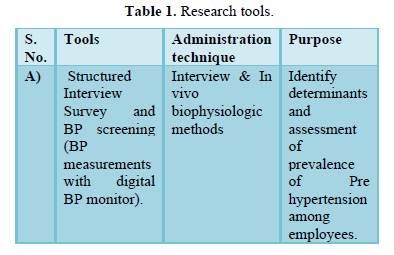
Hypertension survey and screening
The determinants such as age, sex, name and number of selected industries was collected by interview method from the participants.
Pre hypertension screening was done by digital BP monitor which reads BP from 40 to 260 mm of Hg.
Blood pressure was measured as per WHO/JNC-VII guidelines by the investigator. Two readings of BP were taken the left upper arm with the help of digital type of BP monitor at the interval of five minutes in sitting position. The average of these two reading was considered as the final reading (Table 2).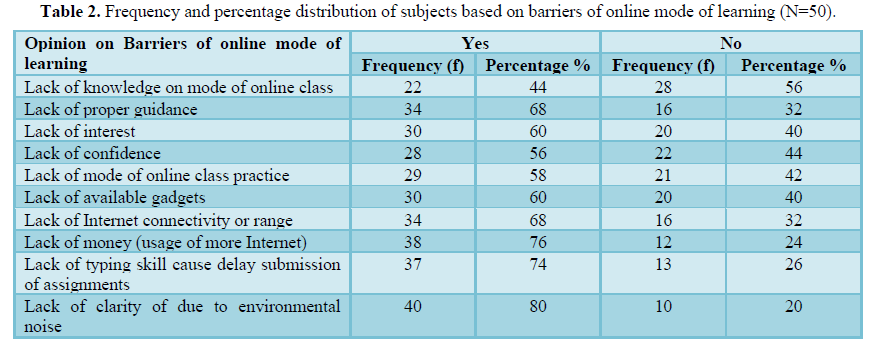
Content Validity
The instruments developed in English by the investigator was translated into Tamil by experts and all Tamil instruments was back translated in to English by experts to improve the content validity of the tool. Digital BP monitor was calibrated from department of Biomedical Engineering.
Pilot Study
Sixty employees were participated for the survey and pre hypertension screening. The estimated prevalence of pre hypertension was 40%.
Ethical Consideration
The proposed study was conducted after the approval by the Research Degree Committee of Himalayan University, Arunachal Pradesh prior to the study. Ethical clearance was done. Permission was obtained from the selected industries. The consent of the participants was obtained.
Formal approval was obtained from the Institutional review board of Himalayan University. To execute the study the researcher obtained official written permission from managers from concerned industries. Informed consent was obtained from the samples related to the study purpose, type of data, nature of commitments, participation and procedure.
Method of Data Collection Procedure
All the employees who participated in the study from the selected industry were involved in interview survey and screening. Each industry, employees was surveyed one by one privacy was maintained. Two BP reading were taken and the average of the two was noted. The investigator spent approximately 5-10 min per sample to collect data.
Data collection was carried out form September 2016 to January 2018.
Plan for Data Analysis
Prevalence calculation formula was used to find the percentage of prevalence of prehypertension (Figure 1).
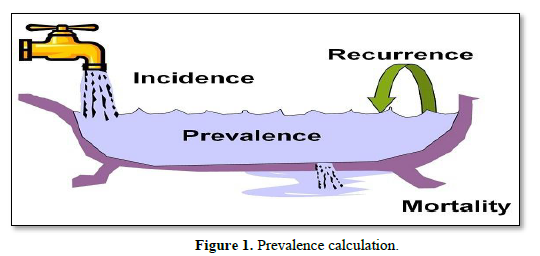

FINDINGS
Association of the variables and hypertension
More number of participants that is 50% were in the age group between 36-45 years, 35% were in age group between 45-55 years, 15% of the participants were in the age group between 25-35 years. With regard to sex maximum samples that are were 93.33% females, only 6.67% were men. Majority of the participants 53.34% had primary school education, 16.67% of them had secondary school education, 14.16% of samples had tertiary education, 13.33% of subjects had no formal schooling and 2.5% had technical education. On the association between the pretest score on knowledge level regarding prevention of hypertension and age (c2(40) =56.2), education (c2(2) =60.8), place of residence (c2(2) =15.86), category of work (c2(12) = 47.21), are significant at 0.050 level (Table 3).
The prevalence of pre hypertension among employees according to determinants score in selected industries (Table 4).

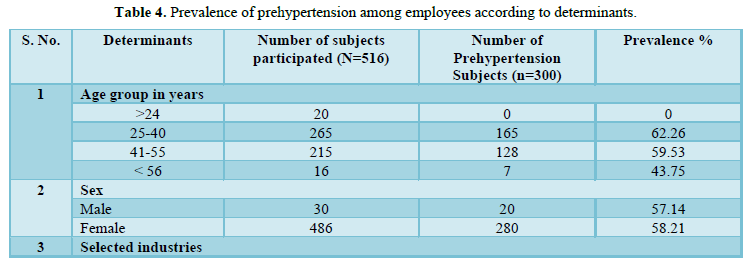

Column diagram shows among 516 participants, majority (62.26 %) was found of pre hypertension in the age group of 25-40 years. Among sex 58.21 % of prevalence of prehypertension was found in females and 57.14% was found in males. Among the list of selected industries majority (66.67%) prevalence of pre hypertension was found industry III and V (Figure 2).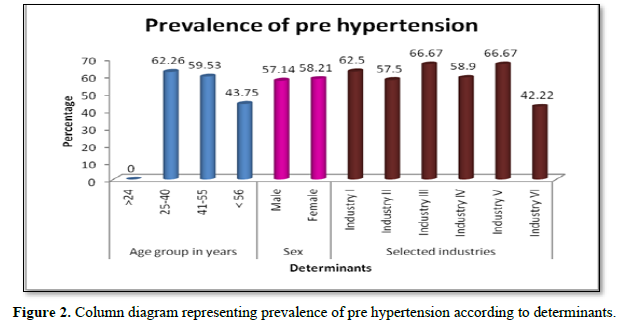
DISCUSSION
This study finding was supported by the past literatures Spark, [9] said that according to the American Heart Association, 59 million people in the United States employees have prehypertension. Employees with pre hypertension may have greater risk for other Cardiovascular Disease risk factors such as high cholesterol, obesity and diabetes. Pre hypertension is a warning sign that may get hypertension in the future. High blood pressure increases the risk of heart attack, stroke, coronary heart disease, heart failure and kidney failure. There was no cure for high Blood Pressure, but there is a treatment with diet, lifestyle habits and dedications. Wellness Intervention and Physical Activity had also a considerable effect on lowering health care costs. In any case, preventing the progression of pre hypertension to hypertension is an important individual patient and health care system goal.
CONCLUSION
Heart disease is not a man’s disease, but an equal opportunity disease. Occupational health services are the essential component of community health. The nurse has a key role in occupational health as she is a link between the medical practitioner and the workers. The finding of the present study may be helpful for such future studies. The occupational nurse has to take part in early diagnosis and treatment of diseases in industrial workers. Most of the research effect in the field of industry are conducted by other professionals. So, there is a need conduct future research studies in the field of nursing. The similar study can be done by other industries like medical, administrative and driving field.
The findings of the prevalence are comparable to the World Health Organization estimates which gives the prevalence of hypertension in India. The comparative study can be done by same setting with another industrial field. The similar study can be conducted in different setting like small and large industries. A comparative study can be done with different groups of people from urban and rural areas. A study may be conducted to determine the effectiveness of wellness in sedentary bank, teaching employees.
On the basis of the present study and also keeping in mind the limitations of the study, the following suggestions are put forth for future research. The similar study can be replicated on large sample and on sample with different demographic characteristics to generalize the findings. A comparative study can be done with different groups of people from urban and rural areas.
The prevalence of the lifestyle health problems and labour welfare facilities can be studied with in the industrial workers. A protocol can be formed for the hazard free industry and can be given to workers.
- Flower J (2009) Fundamental aspects of community nursing. 1st ed. CBS publishers & distributors, India, pp: 100-101.
- William A (2013) United States Department of Health and Human Services. Effectiveness of employee well-being programme. Available online at: http://www.rand.org/health
- Mohan V, Wilson DE, Valvlack T, Brendin (2009) Lifestyle factors in hypertension. Int J Hypertens.
- Hu L, Huang X, You C, Li J, Hong K, et al. (2017) Prevalence and risk factors of pre hypertension and hypertension in southern China. PLoS One 12(1): e0170238.
- Bharathi DR, Nandi P, Yamuna TV, Lokeshmaran A, Agarwal L, et al. (2011) Prevalence and covariates of undiagnosed hypertension in adult. Nepal J Epidemiol 2(2): 191-199.
- Indian Council of Medical Research survey (2009) Natural Institute of Medical Statistics: Non-Communicable risk factor survey. Tamil Nadu, India.
- Mathur JS (2007) Preventive and social medicine. 2nd ed. A Comprehensive Text books. CBS Publishers & Distributors, Chennai, India, pp: 11.
- Dhaar GM, Robbani I (2008) Foundation of community medicine. 2nd ed. Elsevier India private Limited. India, pp: 544.
- Louise LC, Spark GR, Donovan R (2015) Health promotion strategies and methods. 2nd edition. MC grow Hill Company, New Delhi, pp: 50-51.
QUICK LINKS
- SUBMIT MANUSCRIPT
- RECOMMEND THE JOURNAL
-
SUBSCRIBE FOR ALERTS
RELATED JOURNALS
- Advance Research on Endocrinology and Metabolism (ISSN: 2689-8209)
- Journal of Otolaryngology and Neurotology Research(ISSN:2641-6956)
- Journal of Cancer Science and Treatment (ISSN:2641-7472)
- Journal of Allergy Research (ISSN:2642-326X)
- Journal of Rheumatology Research (ISSN:2641-6999)
- Journal of Oral Health and Dentistry (ISSN: 2638-499X)
- Journal of Carcinogenesis and Mutagenesis Research (ISSN: 2643-0541)



